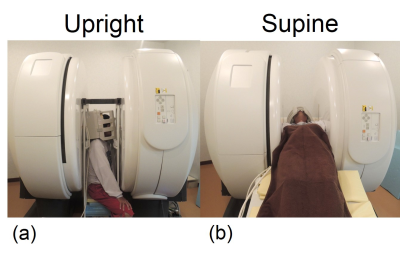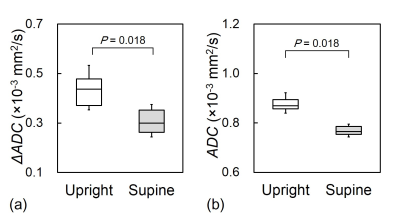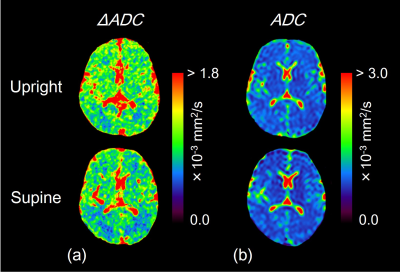5344
Investigation of the Effect of Body Posture on Dynamic ADC Change during Cardiac Cycle in Human Brain1Institute of Medical, Pharmaceutical and Health Sciences, Kanazawa University, Kanazawa, Japan, 2Department of Neurosurgery, Nagoya City University, Nagoya, Japan
Synopsis
Intracranial conditions are strongly affected by body posture. Apparent diffusion coefficient (ADC) of the brain significantly changes during the cardiac cycle, and this change (ΔADC) reflects intracranial condition. However, the effect of body posture on ΔADC has yet to be confirmed. Therefore, we evaluated the ΔADC and ADC of the brain in upright and supine postures using a multi-posture MRI. ΔADC and ADC of the white matter in the upright posture were significantly higher than those in the supine posture. Multi-posture MRI facilitates the noninvasive evaluation of the effect of gravity on intracranial conditions.
Introduction
Intracranial conditions, eg., intracranial pressure, cerebral hemodynamics, and cerebrospinal fluid flow dynamics, are strongly affected by body posture. Alperin et al have reported the gravity-induced difference in the intracranial pressure (ICP) between upright and supine postures.1 We have previously demonstrated that the apparent diffusion coefficient (ADC) of the brain significantly changed during the cardiac cycle.2-3 This change (ΔADC) shows the degree of fluctuation of water molecules in the brain and reflects intracranial condition. However, the effect of body posture on ΔADC has yet to be confirmed because magnetic resonance imaging (MRI) of the brain is usually performed in the horizontal supine position. Therefore, the purpose of this study was to evaluate the ΔADC and ADC of the brain in the upright and supine postures using a novel MRI system (multi-posture MRI) that enables us to perform whole body MRI at any postures.Materials and Methods
On a 0.4-T multi-posture MRI, seven healthy volunteers (all men; mean age, 23.9 years; range, 21-28 years) were scanned in both upright and supine postures (Fig. 1). Electrocardiograph-triggered single-shot diffusion echo-planar imaging of the brain was performed with the following imaging parameters: repetition time, 2 R-R intervals; echo time, 114.1 ms; slice thickness, 4 mm; field of view, 256 mm; imaging matrix, 64 × 64; number of signals averaged, 2; cardiac phases, 22-33 (depending the subject’s heart rate); and b-value, 0 and 500 s/mm2. ADC image for each cardiac phase was created. We then determined the maximum change in ADC (ΔADC) and mean ADC during the cardiac cycle in the white matter. These values were compared between the upright and supine postures.Results and Discussion
Compared with the supine posture, ΔADC and mean ADC of the white matter in the upright posture were significantly higher by factors of 1.4 and 1.1, respectively (Figs. 2 and 3). These results indicate that body posture affects both fluctuation and diffusion of water molecules in the brain. ΔADC has a linear relationship with cerebral blood flow (CBF) as well as water molecules fluctuation of the brain.4 However, it has been reported that CBF is slightly reduced in the upright posture.1 Therefore, the increase in ΔADC in the upright posture may be associated with change in ICP rather than CBF.Conclusion
ΔADC and ADC of the brain increase in the upright posture. Multi-posture MRI facilitates the noninvasive evaluation of the effect of gravity on intracranial conditions.Acknowledgements
No acknowledgement found.References
1. Alperin N, Lee SH, Sivaramakrishnan A, et al. Quantifying the effect of posture on intracranial physiology in humans by MRI flow studies. J Magn Reson Imaging. 2005; 22: 591-596.
2. Nakamura T, Miyati T, Kasai H, et al. Bulk motion-independent analyses of water diffusion changes in the brain during the cardiac cycle. Radiol Phys Technol. 2009; 2: 133-137.
3. Ohno N, Miyati T, Mase M, et al. Idiopathic normal-pressure hydrocephalus: temporal changes in ADC during cardiac cycle. Radiology. 2011; 261: 560-565.
4. Takatsuji M, Miyati T, Ohno N, et al. Correction of the Blood Flow Effect Using Perfusion-Related Diffusion for Brain-Fluctuation MRI in Healthy Volunteers: a Preliminary Study. Med Imag & Info Sci, 2017; 34: 132-135.


